January 8, 1942
 Stephen Hawking Google Videos
Stephen Hawking Google VideosStephen Hawking is a English theoretical physicist who is one of the
world's leaders in his field. His principal areas of research are
theoretical cosmology and quantum gravity. He is known for his
contributions to the fields of cosmology and quantum gravity.
***
SUNSPOT GONE: The first sunspot of 2009, which appeared
yesterday in the sun's southern hemisphere, has fizzled. The
sunspot's dark core coalesced, then dissolved again in just under
24 hours. That was enough time to measure the sunspot's magnetic
field, however, and the polarity of the field identified the spot
as a member of new Solar Cycle 24. Those are the kind of sunspots
we want to see because they mean solar minimum is coming to an end:
audio.
APPROACHING COMET: Comet Lulin (C/2007 N3), discovered in 2007
by a Strait-bridging team of astronomers from Taiwan and China, is swinging around the
sun and approaching Earth. Astronomer Karzaman
Ahmad sends this picture taken Jan. 7th from the Langkawi National
Observatory in Malaysia:
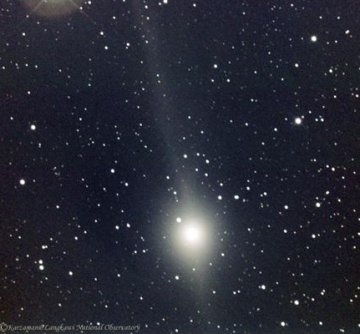
"I used the observatory's 20-inch telescope for an exposure
of 24 minutes," he says. "The image shows the comet's
bright tail and an anti-tail."
Right now, Comet Lulin is gliding through the constellation Libra
in the southeastern sky before dawn: sky
map. It glows like an 8th magnitude star, so a mid-sized backyard
telescope is required to see it. Visibility will improve in February
as the Earth-comet distance shrinks. At closest approach (0.41 AU)
on February 24th, the comet should brighten to about 5th magnitude--dimly
visible to the unaided eye and an easy target for binoculars: ephemeris.
Surprises are possible. The near-parabolic orbit
of Comet Lulin suggests this could be the comet's first visit
to the inner solar system. How it will react to increasing sunlight
is anyone's guess. Stay tuned for updates in the weeks ahead.
more images: from
Babak Tafreshi in the Alborz Mountains of Iran; from
Riccardo Di Nasso of Pisa, Italy
RECIPE FOR BEAUTY: Start with one bright Moon. Add seven mythical
sisters. Mix in a splash of floating water droplets and voilà!--last
night's sky over Auburn, Alabama:
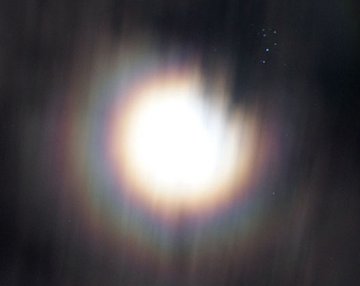
"It was pretty cool," says photographer Jonathon
Stone. "A bright lunar corona appeared as these clouds
drifted in front of the Moon. I didn't know the Moon would be so
close to the Pleiades--but there they were."
The nights ahead could be filled with scenes like this. The Moon
is waxing full and shining through northern winter clouds, painting
the sky with lunar
coronas, moon
halos, pillars and 'dogs.
Look up after dark!
From www.spaceweather.com
~~~~~~~~~~~~~~~~~~~~~~~~~~~~~~~~~~~~~~~~~~~
Cosmic Radio Noise Booms Six Times Louder Than Expected

The
balloon-borne ARCADE instrument discovered this cosmic static (white
band, top) on its July 2006 flight. The noise is six times louder than
expected. Astronomers have no idea why. Credit: NASA/ARCADE/Roen Kelly
Loud sounds tend to startle us. But imagine being surprised by a sound
six times louder than you expect. A balloon-borne instrument called
ARCADE, (Absolute Radiometer for Cosmology, Astrophysics, and Diffuse
Emission) was supposed to be used to search for heat signature from the
first stars to form after the Big Bang. Instead it found an unexplained
"booming" radio static that fills the sky.
Click to continue…
Which Comes First: Galaxy or Black Hole?
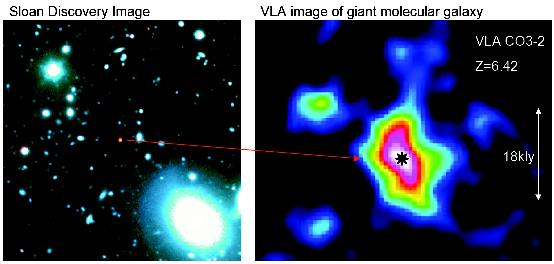
Enlarge
VLA image (right) of gas in young galaxy seen as it was when the
Universe was only 870 million years old. Image: NRAO/AUI/NSF, SDSS
Do galaxies form first and then a black hole springs up in the center,
or possibly, do galaxies form around an already existing black hole?
That's the cosmic chicken-and-the-egg problem astronomers have been
trying to figure out. The answer? "It looks like the black holes form
before the host galaxy, and somehow grow a galaxy around them. The
evidence is piling up," said Chris Carilli, of the National Radio
Astronomy Observatory (NRAO), speaking at today's press conference at
the American Astronomical Society's meeting. By observing with the Very
Large Array radio telescope and the Plateau de Bure Interferometer in France at sub-kiloparsec
resolution, the researchers have been "weighing" the earliest galaxies,
ones that formed within a billion years of the Big Bang.
Click to continue…
WR 104 Won't Kill Us After All
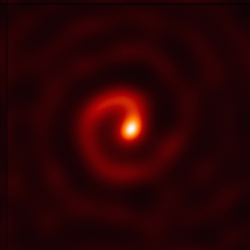
WR 104, not so scary (Keck)
Early last year, concern was growing for a Wolf-Rayet star named WR 104 that appeared to be aiming right at Earth (see Looking Down the Barrel of A Gamma Ray Burst).
A Wolf-Rayet star is a highly unstable star coming to the end of its
life, possibly culminating in a powerful, planet-killing gamma-ray
burst (GRB). GRBs are collimated beams of high energy gamma-rays,
projected from the poles of a collapsing Wolf-Rayet star. It was little
wonder that we were concerned when a dying Wolf-Rayet star was found to
be pointing right at us! Today, at the AAS in Long Beach, one scientist
working at the Keck Telescope has taken a keen interest in WR 104 and shared new findings that show
our Solar System may not be bathed in deadly gamma-rays after all…
Click to continue…
Atmospheres of Super Earths
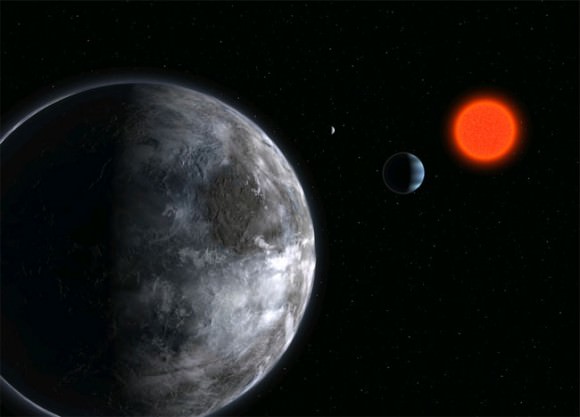
We stand on the edge of the next phase of planetary discovery. Hundreds of massive, Jupiter-like
planets have been discovered, but now astronomers are turning up
smaller, more familiar planets. Planets the mass of Earth are out of
reach today, but a new class of super Earth planets are now being
discovered, and more will be turned up with the next generation of
ground and space-based telescopes. Perhaps the most interesting research will be in the atmospheres of these planets.
Click to continue…
Invading Stars Faster Than Speeding Bullet
A team of astronomers looking for pre-planetary nebulae using the Hubble Space Telescope instead came across some renegade stars screaming through space. These
runaway stars are moving along at 50 km/s (112,000 miles an hour), and
have traveled an estimated 160 light years from where they originated.
“We think we have found a new class of bright, high-velocity stellar
interlopers,” says astronomer Raghvendra Sahai from JPL. “Finding these
stars is a complete surprise because we were not looking for them. When
I first saw the images, I said ‘Wow. This is like a bullet speeding
through the interstellar medium.’ Hubble’s sharp ‘eye’ reveals the
structure and shape of these bow shocks.”
Click to continue…
Could Quark Stars Explain Magnetars Strong Magnetic Field?
Magnetars
are the violent, exotic cousins of the well known neutron star. They
emit excessive amounts of gamma-rays, X-rays and possess a powerful
magnetic field. Neutron stars also have very strong magnetic fields
(although weak when compared with magnetars), conserving the magnetic
field of the parent star before it exploded as a supernova. However,
the huge magnetic field strength predicted from observations of
magnetars is a mystery. Where do magnetars get their strong magnetic fields? According to new research, the answer could lie in the even more mysterious quark star…
Click to continue…
This Week's Where In The Universe Challenge

This week's Where In The Universe Challenge has a new twist. This image
was actually submitted by one of our readers, Wienie van der Oord from
Israel. Its quite an interesting image, don't you agree?! I'll not give
any hints as to where Wienie got the image, or what it is, or whether
this image can be found anywhere else on the web (for those of you that
like to search online for the image and link the answer!). You'll have
to wait until tomorrow (Thursday) for the answer to be revealed for
this week's Challenge. My only hope is that some conspiracy theorist types don't see this and claim this image is proof of life on an alien world. Or, possibly, could it really be…..?!
Check back tomorrow to find out! It will be interesting to see the guesses on this one, so submit 'em in the comment section.
Click to continue…
AAS Session 328: Black Holes I, January 6th
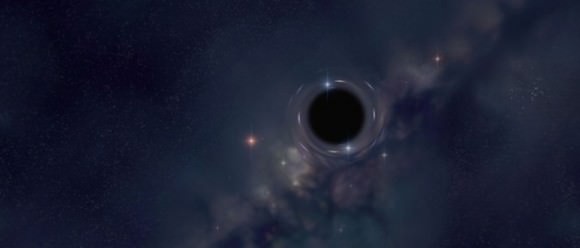
The debate of whether or not a supermassive black hole (SMBH) was
kicked out of the centre of a galaxy continues in the Black Holes I
session at the AAS. According to Stefanie Komossa and her team at the Max Plank Institute for extraterrestrial Physics (MPE) back in May 2008,
spectroscopic data of a galactic core appeared to show a collision
event between two SMBHs. In this case, the smaller SMBH was propelled
out of its host galaxy by an intense and focused "superkick" by
gravitational waves.
However, the delegates attending Session 328 have other ideas…
Click to continue…
If Brown Isn't a Color, What Color are Brown Dwarfs?
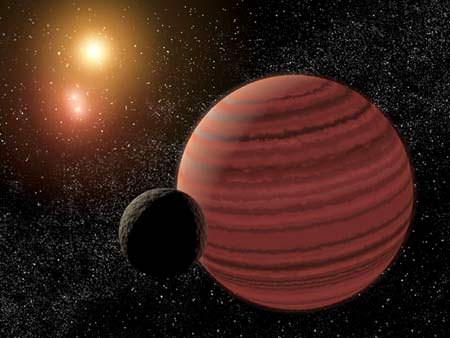
Artist's impression of a brown dwarf. Image credit: NASA/JPL
years. These are the "failed stars"; objects with too little mass to
fully ignite nuclear fusion in their cores. Instead of blazing with
red, yellow or the white light of our own stars, they're heated by the
gravitational collapse of material. They're called brown dwarfs, but
you might be surprised to know that they aren't actually brown. In
fact, it's impossible to have brown light. So what color are they?
Click to continue…
https://www.universetoday.com/
~~~~~~~~~~~~~~~~~~~~~~~~~~~~~~~~~~~~~~~~~~~
Astronomy Picture of the Day
2009 January 8
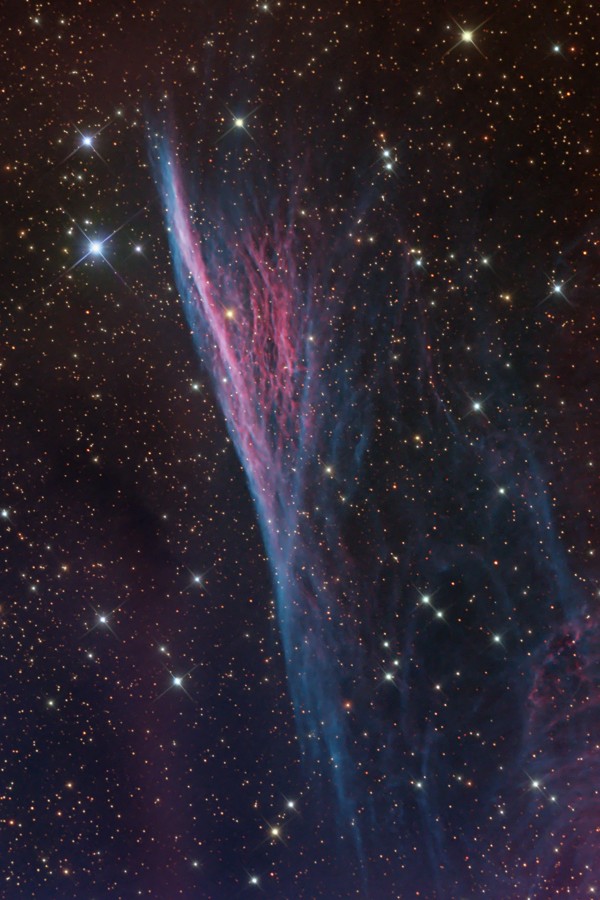
NGC 2736: The Pencil Nebula
Credit & Copyright: Ken Crawford (Rancho Del Sol Observatory)
Explanation: This shock wave plows through space at over 500,000 kilometers per hour.
Moving right to left in the
beautifully
detailed color composite, the thin, braided filaments are actually
long ripples in a sheet of glowing gas seen almost edge on.
Cataloged
as NGC 2736, its narrow appearance
suggests its popular name,
the Pencil Nebula.
About 5 light-years long and a mere 800 light-years away,
the Pencil Nebula is only a small part of the
Vela
supernova remnant.
The Vela remnant itself is around 100 light-years in diameter, the expanding
debris
cloud of a star that was seen to
explode about 11,000 years ago.
Initially, the shock wave was moving at millions of kilometers
per hour but has slowed considerably, sweeping up
surrounding interstellar gas.
https://antwrp.gsfc.nasa.gov/apod/astropix.html
~~~~~~~~~~~~~~~~~~~~~~~~~~~~~~~~~~~~~~~~~~~~~~~
PHOTO IN THE NEWS: Milky Way's Turbulent Core in Hi-Res
https://news.nationalgeographic.com/news/2009/01/090106-milky-way-photo.html
 | ||
The first infrared panorama of the Milky Way's center (detail of the full panorama above) has revealed a previously unknown population of massive stars scattered across the turbulent zone around our galaxy's core. A composite of Hubble and Spitzer space-telescope observations, the panorama covers a 300-by-115-light-year area with a high enough resolution that—even at a distance of 26,000 light-years from Earth—objects as small as 20 times the size of our solar system are brought to light. Among these object are about 26 million stars, 300 of which can be identified as massive stars that are relatively young—a few million years old or less. About two-thirds of those 300 are single stars that are unexpectedly lying outside the three known clusters of star formation. "Because these stars are in isolation, they either formed this way or they spun out recently from very massive star clusters," said study leader Q. Daniel Wang, of the University of Massachusetts. The new view also gives scientists the sharpest look yet at odd structures within the galactic core, including fluffy fingers of gas sculpted by winds streaming from a large star cluster (lower left) and the pinwheel of material spiraling into the supermassive black hole at our galaxy's heart (lower right). "This is an important step in establishing the center of our galaxy as a laboratory to study the complex interactions between massive stars and the harsh environments of the nuclear regions of galaxies in general," Wang said. He and colleagues unveiled the new image Monday at an American Astronomical Society meeting in Long Beach, California. —Victoria Jaggard Hubble image courtesy NASA, ESA, and Q.D. Wang (University of Massachusetts, Amherst); Spitzer image courtesy NASA, Jet Propulsion Laboratory, and S. Stolovy (Spitzer Science Center/Caltech) | ||



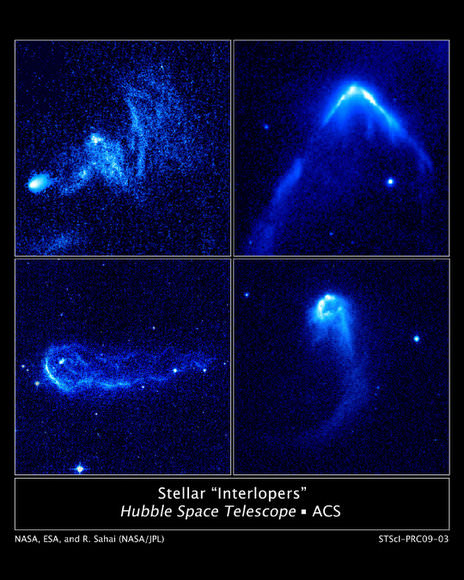
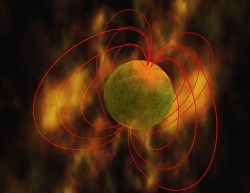
That's some relieving news about WR 104...I didn't like thinking about the alternative.
I don't know where the heck we are! It's on a planet, maybe a moon...I say planet, no moon, no planet...I'm going to say .... hmmmmmm ... a MOON.
You know, I like that pic (impression) of the brown dwarf...I just like the whole look of it. But, now I'm going to go look to see what color the brown really is if it isn't really brown.